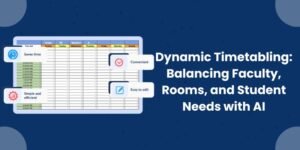In the digital age, educational institutions are inundated with vast amounts of data. From admission forms and student transcripts to examination results and degree certificates, the volume of documents that need to be processed, stored, and managed is staggering. Traditional manual methods are no longer sustainable. This is where AI-powered document processing comes in, transforming how academic institutions handle their record-keeping.
In this blog, we’ll explore how artificial intelligence is revolutionizing academic document management, enhancing accuracy, efficiency, and compliance.
What is AI-Powered Document Processing?
AI-powered document processing refers to the use of machine learning (ML), natural language processing (NLP), and optical character recognition (OCR) technologies to automate the capture, classification, extraction, and validation of information from documents.
This approach replaces tedious manual work with intelligent, automated processes that improve speed and reliability. Institutions can now handle vast volumes of documents with reduced human effort and increased consistency.
Key Features:
- Automated data extraction
- Smart document classification
- Error detection and correction
- Real-time data validation
- Seamless integration with existing ERP and SIS systems
Why Traditional Document Handling Falls Short
Many institutions still depend on outdated manual methods to handle academic documentation. These methods are increasingly impractical due to the growing volume of data.
Common Challenges:
- Human error: Mistakes in data entry or document sorting can lead to major issues.
- Time-consuming workflows: Staff must spend hours handling physical paperwork.
- Storage issues: Maintaining physical archives is expensive and inefficient.
- Compliance risks: Inaccurate records can lead to non-compliance with educational and privacy regulations.
Manual systems also lack scalability. As institutions grow, the challenges multiply.
Benefits of AI-Powered Academic Record-Keeping
AI-powered document automation presents a suite of benefits tailored to the unique needs of educational institutions.
1. Improved Accuracy
AI algorithms significantly reduce human errors in data extraction and entry. Machine learning models learn from historical data to improve their precision over time.
Accurate records contribute to better reporting, analysis, and compliance.
2. Faster Processing Time
With automation, institutions can process thousands of documents in a fraction of the time it takes manually. What used to take days or weeks can now be done in hours.
3. Enhanced Data Security
AI systems can detect anomalies and flag suspicious entries, helping protect against data tampering and unauthorized access. With built-in encryption and access control, sensitive student information stays protected.
4. Real-Time Access and Updates
Students, faculty, and administrators can access academic records in real-time through integrated platforms. This improves decision-making, communication, and responsiveness.
5. Cost Efficiency
Automation reduces the need for large administrative teams, saving on operational costs while improving scalability. Institutions can redirect resources to student services and academic development.
6. Regulatory Compliance
AI ensures consistency in data handling and helps institutions adhere to regulations like FERPA, GDPR, and local educational policies. This reduces legal risks and increases trust.
Technologies Behind AI Document Automation
The core technologies that power AI-based document processing include:
1. Optical Character Recognition (OCR)
OCR converts scanned documents and images into machine-readable text. Modern OCR tools like Google Vision API and Tesseract offer high accuracy rates, enabling seamless digitization.
2. Natural Language Processing (NLP)
NLP enables machines to understand context and semantics. This is key in analyzing handwritten notes, academic transcripts, or feedback forms. NLP can even summarize data or classify documents based on content.
3. Machine Learning (ML)
ML models can be trained to recognize and classify different document types, such as application forms vs. exam sheets. These models improve over time, adapting to institutional requirements.
4. Robotic Process Automation (RPA)
RPA bots can automate repetitive tasks like entering data into a student information system (SIS), sending alerts, or generating report cards. This frees up human staff for more meaningful work.
Integration with Existing Systems
One of the biggest strengths of AI document automation is its ability to integrate seamlessly with existing systems.
1. Student Information Systems (SIS)
AI tools can plug into SIS platforms to extract, update, and verify student data in real-time. This ensures accurate records and better service delivery.
Platforms such as VAPS offer seamless integration with existing SIS, ERP, and LMS systems. This interoperability ensures that data flows smoothly across various departments, enhancing operational efficiency and data accuracy.
2. Enterprise Resource Planning (ERP)
Integration with ERP systems helps in aligning academic records with financial and administrative workflows, creating a unified institutional dashboard.
3. Learning Management Systems (LMS)
Seamless LMS integration ensures that academic outcomes and feedback loops are synchronized with official records. Educators can assess and record performance within the same ecosystem.
Challenges and Considerations
Despite the advantages, there are challenges to be addressed.
1. Data Privacy and Security
Handling sensitive student data requires compliance with international and national data privacy laws. Institutions must enforce strict policies and regularly audit data practices.
2. Initial Setup Costs
Deploying AI infrastructure can involve high upfront investment, especially for smaller institutions. However, long-term gains often justify the cost.
3. Training and Change Management
Staff and faculty need to be trained to use new systems, and resistance to change can delay adoption. Ongoing support is essential for a smooth transition.
4. Ongoing Maintenance and Monitoring
AI systems require regular updates, audits, and fine-tuning to stay accurate and compliant. Institutions should allocate resources for continued improvement.
Best Practices for Implementation
For a successful rollout, consider these best practices:
1. Start Small, Scale Gradually
Begin with one process (e.g., transcript automation) and expand based on results. Pilot programs help identify gaps and refine strategies.
2. Choose the Right Vendor
Look for platforms that offer AI-driven document automation with education-specific features. Evaluate vendors based on scalability, support, and integration.
3. Ensure Interoperability
Make sure the system integrates smoothly with existing tools like LMS, SIS, and ERP. APIs and middleware can help bridge gaps.
4. Focus on Data Security
Implement strong encryption, access controls, and regular security audits. Partner with vendors who comply with industry standards.
5. Collect Feedback Continuously
Engage end-users (faculty, staff, students) to gather feedback and optimize system performance. User experience drives adoption and efficiency.
The Future of Academic Record-Keeping
AI in academic documentation is just beginning. Emerging trends include:
1. Blockchain-Based Records
Digital records stored on blockchain will provide tamper-proof, lifelong verifiable credentials. Students can own and share their data globally.
2. AI-Powered Predictive Analytics
Academic data will be used to forecast student success, retention risks, and career pathways. Institutions can personalize support.
3. Voice-Activated Interfaces
Voice search and commands could simplify the way faculty and students retrieve or submit records. This will improve accessibility.
4. Smart Chatbots for Records Requests
AI chatbots will handle routine queries like “Can I get my 3rd-semester transcript?” instantly. This will save time and reduce workload on administrative staff.
A Smarter Way to Manage Academic Records
AI-powered document processing is more than just a technological upgrade; it’s a shift toward a smarter, more agile academic ecosystem. By automating routine tasks, ensuring data integrity, and providing real-time access, AI is enabling institutions to focus on what truly matters: quality education and student success.
With scalable AI solutions, even small institutions can modernize their record-keeping and stay compliant, competitive, and connected.












